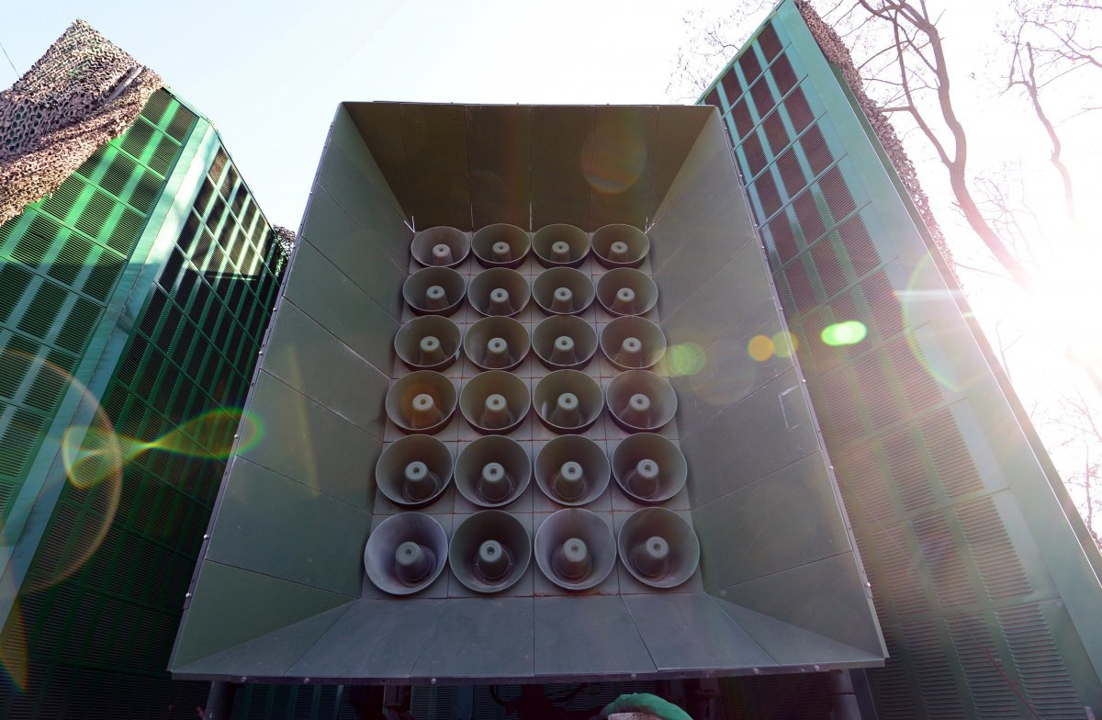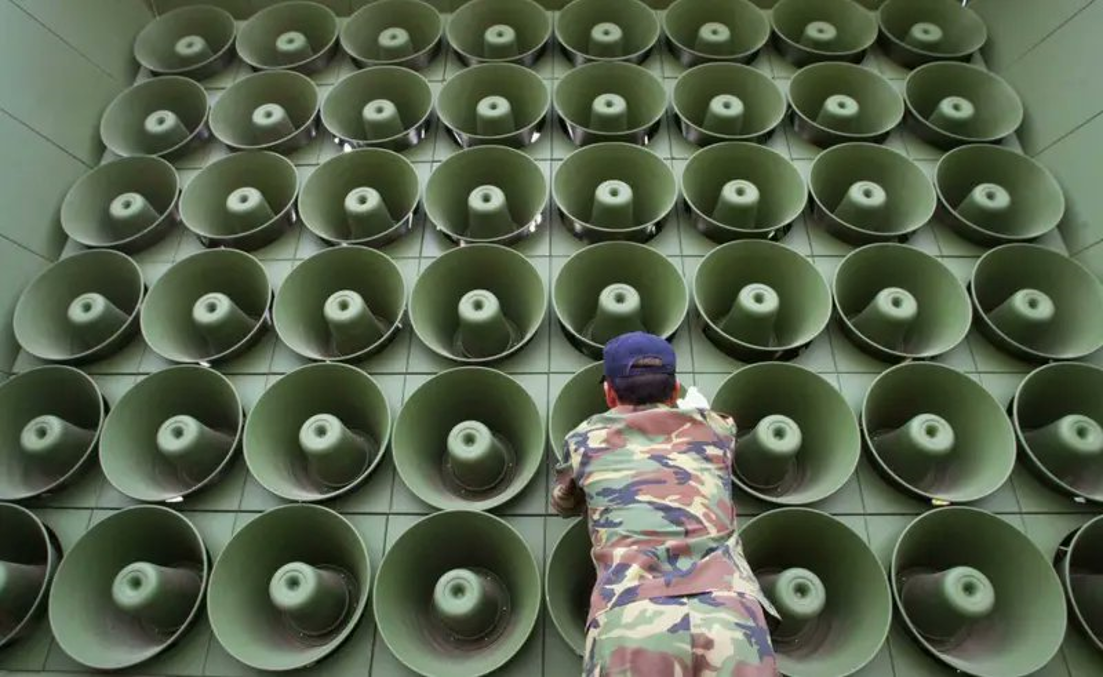On June 9th, South Korea restarted propaganda broadcasts along the Military Demarcation Line (MDL) in response to North Korea launching a three-wave of trash balloons across the border. The broadcasts come as South Korea’s Defense Ministry said the country would suspend the Comprehensive Military Agreement (CMA) in response to North Korea’s trash balloon campaign and GPS signal jamming on June 4th. The Deputy Defense Minister for Policy, Cho Chang-rae, said the “measure is restoring to normality all military activities by our military, which had been restricted by the 2018 pact.” Furthermore, Cho also said that North Korea repeatedly violated the 2018 agreement by firing coastal artillery and rockets south of the Northern Limit Line (NLL) and sending small drones across the DMZ. The ministry’s announcement came after South Korean President Yoon Suk Yeol and the Cabinet Council endorsed a motion to fully suspend the CMA.
Reactivation of Loudspeakers
South Korea’s resumption of propaganda broadcasts along the Military Demarcation Line (MDL) is part of a three-stage response plan: suspension of the CMA; installation of the loudspeakers; and resumption of broadcasting. The government began to implement the second and third stages at once to respond to the potential loss of life or damage to property from the third wave of balloons. An official said the military’s resumption of broadcasting while they install the loudspeakers would depend on “North Korea’s behavior.” The military reportedly prepared various kinds of content to be used during broadcasts called the Voice of Freedom.

The content includes information about North Korea’s trash balloons, the country’s human rights abuses, world news, K-pop songs, and weather information. South Korea’s Joint Chiefs of Staff spokesperson, Lee Sung-jun, said the military could conduct the broadcasts using both fixed and mobile loudspeakers along the MDL. Lee pointed out that “fixed loudspeakers need to be connected to power, and installing them could take hours to a few days,” but mobile loudspeakers can be utilized right away. A government official also pointed out that there are no plans to “immediately install” the fixed loudspeakers since it could further increase tensions, but the South Korean military would operate mobile speakers first if the broadcasts were restarted.

The South Korean military conducted the June 9th broadcast at 4:55 p.m. local time, using fixed loudspeakers at 10 locations along the MDL. The content included a notification about South Korea suspending the 2018 agreement, an explanation of why the country decided to resume broadcasts, and a statement that Samsung Electronics had the most smartphone shipments out of 38 countries around the globe. The broadcast also included news that South Korea, Japan, and the United States condemned North Korea’s continued missile provocations and increased military cooperation with Russia at an International Atomic Energy Agency council meeting. The news broadcast lasted for approximately 30 minutes, then switched to weather updates for various North Korean regions and price trends in North Korean markers. The fixed loudspeakers have an audible range of about 15 miles (24 kilometers), while the mobile units have a greater range.
Military Activities Along the MDL and NLL
The 2018 Agreement set up buffer zones along the MDL and NLL that prohibited artillery, field exercises involving regiment-sized units, and naval drills. The agreement also created no-fly zones along the MDL and the NLL. However, the suspension of the agreement will now allow the South Korean military units based along the MDL and NLL to conduct various drills, allow exercises above the regiment-level, and remove the buffer and no-fly zones around the MDL and NLL. Furthermore, the units can now develop training plans and conduct live-fire exercises to increase front-line defenses near the border lines. Republic of Korea Army (ROKA) units will be allowed to conduct live fire and maneuver training exercises within 3.10 miles (5 kilometers) of the MDL.

The Republic of Korea Marine Corps (ROKMC) also announced plans to conduct maritime shooting training with the K-9 self-propelled artillery units deployed to the Northwestern Islands (NWI) at the end of June. The Marine Corps said the training exercise will occur at the end of the month after the crab season ends, but the date will be flexible depending on weather conditions. The ROKMC reported the training exercise’s scale and date to the Joint Chiefs of Staff, which began the approval process. The ministry said the resumption of the live fire drills “is to restore normal military activities of all our units in the MDL and NWI, which have been restricted by the September 19 Agreement.” Previously, units based on Baengnyeongdo and Yeonpyeongdo had to travel to Mugeon-ri shooting range in Paju-si, Gyeonggi Province, located about 68 to 124 miles (110 to 200 kilometers) from the NWI to conduct live fire exercise.
The process involved shipping the K-9s on cargo ships or barges to Incheon, then offloading and moving the artillery to the shooting range. The unit’s personnel would be sent to Mugeon-ri by both a chartered bus and a passenger ship. However, the units equipped with the Bigung coastal defense and Spike anti-tank missile systems had to train at the ROKMC’s Pohang firing range, which is located over 286 miles (460 kilometers) from the NWI. The movement of the systems and personnel to Pohang to conduct exercises increased training time and required an additional 1.45 million (2 billion South Korean Won) in funding.
The plans for the live-fire exercise come six months after ROKMC K-9 units conducted counterfire training in Baengnyeongdo. The January exercise was South Korea’s response to North Korea’s firing of coastal artillery over the NLL. The ROKMC decided that North Korea’s exercise invalidated the maritime buffer zone and reviewed plans for its units to conduct live-fire exercises on its side of the NLL.
Analysis
South Korea resuming the propaganda broadcasts along the MDL illustrates the country’s willingness to suspend agreements designed to increase inter-Korean cooperation in reaction to North Korea’s increasingly aggressive actions. The reintroduction of both propaganda broadcasts and military activities along the MDL and NLL will likely lead to North Korea escalating their responses to South Korea. Yeon and the Cabinet Council suspended the agreement because the trash balloon campaign was the latest in increasingly aggressive actions that North Korea has taken since both sides signed the 2018 agreement. For example, South Korea suspended part of the agreement as a reaction to North Korea’s successful spy satellite launch in November 2023.
Kim responded by formally suspending the agreement in the same month. South Korea decided to suspend part of the agreement that allowed the country to rebuild guard and surveillance posts on its side of the DMZ. Two months after South Korea suspended part of the pact, North Korea conducted a live-fire test of its coastal artillery that landed south of the NLL. While South Korea reacted with a live-fire exercise of its own, it also began to develop red lines for which it would formally suspend the 2018 agreement. Yeon’s government did not suspend the remaining part of the agreement because doing so would likely increase already high tensions along the border.
North Korea’s campaign further reinforces the notion that South Korea will respond to aggressive actions, since North Korea described it as a response to defector groups launching balloons that carried anti-regime leaflets, USBs, and money across the border. The country launched about 1,400 balloons, divided into four waves, that carried trash south of the DMZ to cities as far south as the capital of Seoul and the city of Incheon. North Korea stated it would stop the campaign if the defector groups agreed to stop launching leaflets and other anti-North Korea propaganda across the MDL. However, the groups continued to launch the balloons because the South Korean government did not have any incentive to stop them. The South Korean government decided to fully suspend the agreement in response to North Korea ignoring South Korea’s warnings and continuing to send balloons.
North Korea’s rationale for stopping the defector groups from continuing the launches is to prevent information that is not under the regime’s control from entering the country. The regime places an increased emphasis on preventing information about South Korea from entering the country by removing any mention of reunification or inter-Korean relations. Furthermore, Kim would likely want to develop a native North Korean identity that is divorced from any notion of reunification or South Korea. The regime would require that all forms of information be absolutely controlled and outside sources be totally banned.
The reintroduction of broadcasts and military activities along the MDL and NLL will likely lead to North Korea escalating its actions towards South Korea. While North Korea previously conducted aggressive actions against South Korea, it did not attempt any actions that would risk a significant escalation, such as the 2010 Yeonpyeongdo bombardment. Kim understands that any aggressive action on the same scale as the bombardment would risk South Korean retaliation that could put his regime in jeopardy. However, the North Korean leader also understands that South Korea would be extremely hesitant to conduct an aggressive response due to the potential for escalation between both sides. Kim would view any military exercises or other activities along the MDL and NLL as an escalation that North Korea would need to militarily respond to. The response would likely consist of North Korean military units firing artillery or rockets at locations near or at the locations where the ROKA or ROKMC units conducted the live-fire exercises. North Korea could also respond by resuming propaganda broadcasts aimed at South Korea or conducting live-fire exercises along the MDL and NLL.

